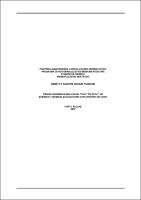| Share record |


|
Please use this identifier to cite or link to this item:
https://tede2.pucrs.br/tede2/handle/tede/1398| Document type: | Dissertação |
| Title: | Valores normativos para o teste Timed Up & Go em pediatria e validação para pacientes com Síndrome de Down |
| Author: | Nicolini-Panisson, Renata D'Agostini  |
| Advisor: | Donadio, Márcio Vinícius Fagundes |
| Abstract (native): | INTRODUÇÃO: O teste Timed Up & Go (TUG) vem sendo utilizado na avaliação da mobilidade funcional e poucos estudos o avaliaram na população pediátrica saudável e em pacientes com Síndrome de Down (SD). OBJETIVOS: Determinar valores normativos para o teste TUG em crianças e adolescentes saudáveis e validar a sua utilização em uma amostra de pacientes com SD. MATERIAL E MÉTODOS: Estudo observacional transversal dividido em duas fases. Crianças e adolescentes, de 3 a 18 anos, saudáveis (fase 1) ou com SD (fase 2),foram selecionadas por conveniência para a avaliação com o teste TUG. As avaliações foram realizadas na seguinte ordem: medidas antropométricas, comprimento real dos membros inferiores, TUG e Gross Motor Function Measure (GMFM), este último realizado apenas na fase 2. A associação entre os valores do teste TUG com as potenciais variáveis preditoras foi analisada utilizando um modelo de regressão linear múltipla. RESULTADOS: Na fase 1 (459 participantes), os valores do teste TUG diferiram no decorrer das idades e por isso foram estratificadas em faixas etárias que servem como valores normativos para ambos os sexos. O modelo de regressão demonstrou que a idade e o peso (R2=0,25) foram as melhores variáveis para a predição do TUG. O coeficiente de correlação intraclasse (ICC) demonstrou excelente confiabilidade intra-sessão e inter-sessão. Na fase 2 (40 indivíduos com SD), o teste também apresentou excelente reprodutibilidade. O tempo de realização foi significativamente maior nos indivíduos com SD quando comparados com os saudáveis pareados por sexo, idade e peso. Ainda, a dimensão E do GMFM foi a variável que melhor se correlacionou com o teste TUG. CONCLUSÃO: Este estudo apresenta valores normativos para o teste TUG e demonstra que o seu comportamento pode ser explicado em função da idade e do peso em crianças e adolescentes saudáveis. O TUG é confiável e válido para avaliação da mobilidade funcional em pacientes com SD e se correlaciona com a função motora grossa. |
| Abstract (english): | INTRODUCTION: The Timed Up &Go (TUG) test has been used in the assessment of the functional mobility and only few studies have tested it in a healthy pediatric population, as well as in patients with Down Syndrome (DS). OBJECTIVES: To determine normative values for the TUG test in healthy children and adolescents and to validate its use in a sample of patients with DS. METHODS: A cross-sectional study divided into two phases. Children and adolescents, from 3 to 18 years old, healthy (phase1), or with DS (phase 2), were selected by convenience to be assessed with the TUG test. The assessments were performed in the following order: anthropometric measurements, actual lower limb length, TUG and Gross Motor Functional Measurements (GMFM) this one was only performed in phase 2. The association between the TUG test values and the possible predictive variables was analyzed using a model of multiple linear regression. RESULTS: In phase 1 (459 participants), the TUG test values were different across the participants age and, because of that, they were stratified in age groups that serve as normative values for both genders. The regression model has demonstrated that the age and the weight (R2=0,25) were the best variables for the TUG test prediction. The intraclass correlation coefficient (ICC) demonstrated excellent within-session and between-session reliability. In phase 2 (40 individuals with DS), the test also showed excellent reproducibility. The performance time was significantly higher in individuals with DS compared with gender, age and weight matched healthy controls. Also, the dimension E of the GMFM was the variable that best correlated with the TUG test. CONCLUSION: This study provides normative values for the TUG test and shows that its behavior can be explained according to the age and weight in healthy children and adolescents. The TUG test is a reliable and valid assessment of functional mobility in patients with SD and correlates with the gross motor function. |
| Keywords: | MEDICINA PEDIATRIA SÍNDROME DE DOWN ATIVIDADES MOTORAS CRIANÇAS ADOLESCENTES |
| CNPQ Knowledge Areas: | CNPQ::CIENCIAS DA SAUDE::MEDICINA::CLINICA MEDICA::PEDIATRIA |
| Language: | por |
| Country: | BR |
| Publisher: | Pontifícia Universidade Católica do Rio Grande do Sul |
| Institution Acronym: | PUCRS |
| Department: | Faculdade de Medicina |
| Program: | Programa de Pós-Graduação em Medicina/Pediatria e Saúde da Criança |
| Access type: | Acesso Aberto |
| URI: | http://tede2.pucrs.br/tede2/handle/tede/1398 |
| Issue Date: | 31-Aug-2012 |
| Appears in Collections: | Programa de Pós-Graduação em Pediatria e Saúde da Criança |
Files in This Item:
| File | Description | Size | Format | |
|---|---|---|---|---|
| 442096.pdf | Texto Completo | 1.08 MB | Adobe PDF |  Download/Open Preview |
Items in DSpace are protected by copyright, with all rights reserved, unless otherwise indicated.




